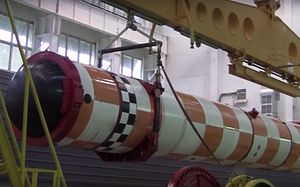Russia will launch its first nuclear-powered submarine capable of carrying the nuclear-capable underwater drone ‘Poseidon,’ alternatively referred to as an unmanned underwater vehicle (UUV), autonomous underwater vehicle (AUV), or simply an intercontinental-range, nuclear autonomous torpedo, according to Russian President Vladimir Putin.
“Nothing has been said about this so far, but it is possible to do so today,” Putin said during his annual address to the Russian Parliament in Moscow on February 20. “In the spring of this year the first nuclear powered submarine armed with this unmanned vehicle will be launched. The work is proceeding in accordance with the schedule.”
The Russian president did not specify the Russian nuclear-powered submarine class expected to receive the Poseidon.
Likely candidates are the Project 09852 submarine, based on the 949A Oscar II-class nuclear-powered guided missile submarine, which was laid down in December 2012 at at the Sevmash shipyard in Severodvinsk, a port city on Russia’s White Sea, and the Project 09851 submarine, purportedly a downsized variant of the Borei-class of nuclear-powered ballistic missile submarines, laid down in July 2014 at the Sevmash shipyard.
“Two Poseidon-carrying submarines are expected to enter service with the Northern Fleet and the other two will join the Pacific Fleet,” a Russian defense industry source told TASS news agency on January 12. “Each of the submarines will carry a maximum of eight drones and, therefore, the total number of Poseidons on combat duty may reach 32 vehicles.” As I explained:
Notably, while the source cites the total number of UUVs to be carried by each of the upgraded submarines at eight, past Russian sources noted that the Project 09852 boats will only be capable of carrying up to six UUVs, while Project 09851 submarines would accommodate up to four Poseidon UUVs. Given the purported size of the Poseidon UUV — twice the size of a submarine-launched ballistic missile — the latter number appears to be somewhat more realistic.
Current underwater tests of the Poseidon have reportedly been conducted by a B-90 Sarov-class Project 20120 diesel-electric submarine, which served as the launch platform for the UUV.
Sea trials of the Posedon UUV were reportedly successfully completed. Yet, the precise nature of the trials remains unclear, as I pointed out in the past:
Russia purportedly commenced sea trials of the Poseidon in December 2018. The ongoing tests are part of experimental design work rather than full-fledged sea trials, according to a Russian defense industry source. As I reported previously, Russia’s MoD already announced in July that sea trials, primarily focused on the UUV’s guidance system and underwater operations in autonomous mode, were under way.
As I noted elsewhere, the Russian Navy is expected to receive up to 30 Poseidon UUV. The Poseidon is also listed in Russia’s state armament program for 2018-2027. The first UUVs are expected to be delivered to the Russian Navy in the late 2020s. It is unclear whether the UUV serves only as a nuclear-warhead delivery platform or could be used for other purposes including intelligence, surveillance, and reconnaissance (ISR) missions.
The UUV, known under Ocean Multipurpose System Status-6 or “Kanyon” by the U.S. intelligence community, “is a new intercontinental, nuclear armed, nuclear-powered, undersea autonomous torpedo,” according to the 2018 U.S. Nuclear Posture Review.
































